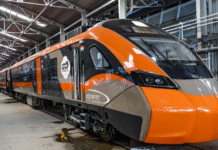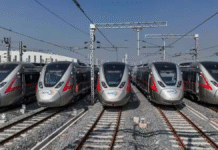KOCHI (Metro Rail News): Mass Rapid Transport (MRT) Experts advocate the ‘Metrolite’ (light urban rail) system for the Kochi metro’s Kakkanad and other extensions. The Centre exercised restraint while approving the costly conventional metro rail projects in various States and prompted the Metrolite system and it leaves a minuscule carbon footprint and cost approximately a quarter of the project cost of the metro rail system.
Centre has readied a policy to promote Metrolite systems like trams, which can operate on the existing arterial roads. Within trams, there are conventional trams that operate on rails and newer systems which do not need tracks.
a technical expert who was associated with numerous metro rail initiatives in India said that the trackless systems in which the trams have rubber wheels like buses are operational in several world cities including in China. Trams rely on sensors to move along a pre-determined track. Such technological advancements have considerably lessened the cost of Metrolite systems.
The clamour for systems like trams comes in the wake of the realisation that the conventional metro rail system costs over ₹250 crores per km. Trams that operate at comparable speeds as those of the metro offer similar comfort and have much lesser ticket fares.
The advantage of track-less trams which carry over double the number of passengers in a bus is that they can negotiate sharp curves just like buses, doing away with the need to acquire land.
buy lipitor online medstaff.englewoodhealth.org/wp-content/languages/new/lipitor.html no prescription
This apart, a basic shelter for commuters to wait is all that is required at the centre of the road, facing tramways on either side, unlike heavy concrete structures that are needed for elevated or underground metro stations.
A few lakh tonnes of concrete are needed for metro rail systems for piles, pile caps, pillars, and girders. Tram shelters can be built every 600 metres or so due to their simple construction style, benefiting more number of commuters than the metro.
The doing away with elevated/underground track, minimal land acquisition [in case it is needed] etc., offer the added advantage of carrying out little or no physical change on the urban landscape. It also does away with extensive security checks and deployment of a massive workforce to man station buildings. Neither do they have ‘barriers’ to surmount like steps and escalators in metro rail stations.
Trams can rely on flash-charging method to recharge their batteries during a halt at stations. Such Metrolite tramways are good for low-density cities like Kochi, where capital-intensive metro rail systems need not get sound ridership. Such systems are comparable to high-capacity bus systems, with similar flexibility as far as extensions and diversions are concerned. All this bring about faster project implementation in a sustainable manner at a much lesser cost, while catering for more commuters than the metro, he observed.
Trams were the preferred mode of transport from 1890s to 1940s till they were withdrawn in favour of buses and cars, which ended up polluting the atmosphere and causing frequent accidents.





